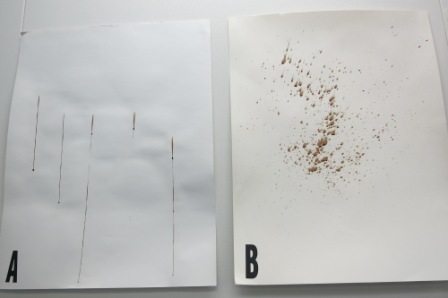Interpreting Bloodstain Patterns
The ability to effectively interpret bloodstain patterns is a science and an art. But, before investigators can dive into a crime scene, they must learn a bit of terminology, such as:
Angle of Impact – the angle formed between the direction of an individual drop of blood and the surface it strikes.
AOI – angle of impact
Back Spatter – blood that’s directed back towards the source of energy, such as a hand holding a firearm, or hammer.
Back spatter from close range gunshot
Expirated blood – blood that’s forced from the mouth or nose where air (exhalation) is the propellant.
Expirated blood spatter
High Velocity Impact Spatter (HVIS) – bloodstain pattern caused by a high velocity impact, such as those caused by gunshots or fast moving equipment or machinery (saws, drills, etc.)
High velocity Impact Spatter (HVIS)
Point of Convergence – the point (two dimensional) where the direction of travel (blood droplets) intersect. Can be used to help determine where the victim was standing when the fatal injury was delivered.
Point of convergence
Point of Origin – the point (three dimensional) where the direction of travel (blood droplets) intersect.
Point of origin
Stringing – a method used to determine the point of origin. Investigators tie strings at the blood drops, following the direction of travel. The point where the strings intersect is the point of origin. Lasers are often used today in lieu of strings.
Stringing
Here is a fantastic video of how investigators solve murders using blood evidence. Very interesting.
* My online Writers Police Academy will soon be up and running. In the coming days, I’ll be asking for a show of hands from those of you interested in signing up. It’s the next best thing to attending a real police academy! More details soon.
* Be sure to stop by Terry Odell’s blog tomorrow for another Homicide-Hussey story. They’re great!






